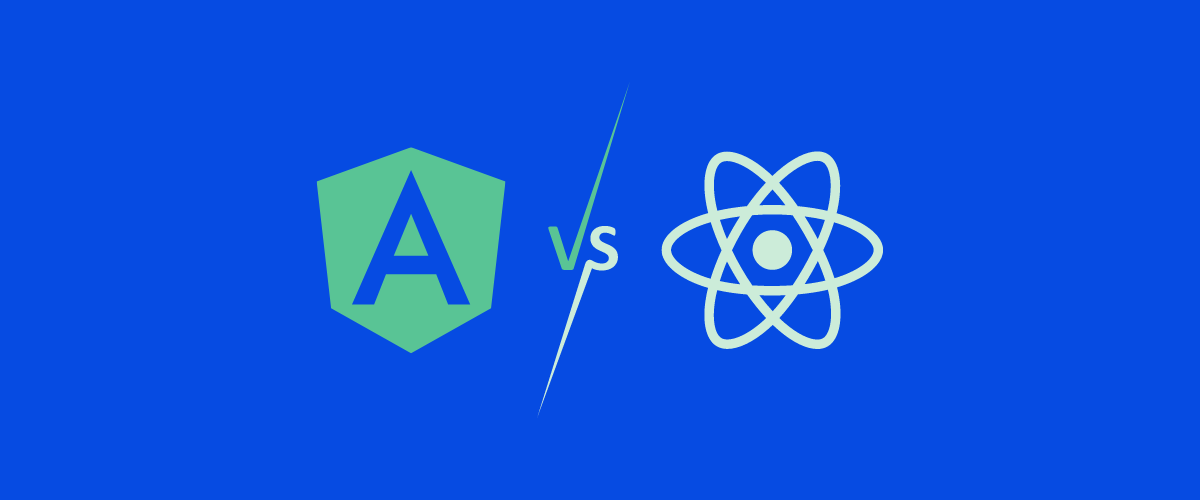In the era of technological evolutions, web development is the backbone of most businesses.
Deciding on the right tech stack and developer for your project can help to expedite and scale your company’s operations and will determine your product’s flexibility, scalability, interoperability, and future.
In other wordsit is an extremely vital decision that cannot be made in haste!
To make this decision easier for you, we are about deep dive to compare the top contenders for web development–React, Angular, and Ajax to help you make an informed decision
Before we start, let’s briefly overview what is Angular, what is Ajax, and what is React technology.
Let’s dive in.
Table of Contents
What is Angular?
Angular, with its various versions like “AngularJS “, “Angular V2”, or “Angular 2“, is a fully-featured, open-source, JavaScript web-application framework that was founded in the year 2009.
Angular is used for building highly-interactive, dynamic web apps and single-page web apps. It lets developers use HTML as a template language and permits HTML’s syntax to express the application’s components clearly and briefly.
Google introduced Angular JS in 2012, based on the MVC framework and rose to fame as it was loaded with many strong features such as:
Data binding that triggered automatic updates of the model view whenever the data is modified and vice versa.
Dependency injection was another powerful concept which enabled application components to be wired unitedly in a way that facilitated testable and reusable code.
Angular, built with TypeScript, a superset of JS, is ideal for front-end development as it offers lots of tools that help developers to start application crafting right away. It is loaded with benefits such as:
- You are empowered with directives to give HTML elements dynamic behavior. You can use FormControl to power up the forms and introduce countless validation rules.
- Routing can be set up with little or no hassle.
- Various types of asynchronous HTTP requests can be sent out with ease.
Well, that’s not it. There is more.
Angular also attempted to eliminate tight coupling between numerous components of the application. Injection normally happens in the node.js style. Several components can be easily replaced.
Node’s package manager or so-called NPM is extensively used to install Angular and other components.
Angular also supports both end-to-end and unit testing with tools like Protractor and Jasmine.
It is supported on all platforms such as — web, mobile, and desktop native. It is all-powerful, modern, and has an active large community of passionate users and a nice ecosystem in general.
Some top giants using Angular: Microsoft, Apple, Adobe, YouTube, PayPal, Google, etc.
Learn more about the latest cost of AngularJS development
What Is AJAX?
AJAX, short for Asynchronous JavaScript and XML, was developed by the Microsoft outlook web applications in the year 1999.
It refers to a group of interconnected technologies such as JavaScript, CSS (cascading style sheets), HTML/XHTML, DOM (document object model), XML (extensible markup language), XMLHttpRequest, and Microsoft Object.
Ajax development techniques help in building faster, better, and super interactive websites and web applications.
The core function of Ajax is to asynchronously update web content, justifying the “A” of AJAX. This means a user’s web browser doesn’t need to refresh the entire web page while changing a small portion of the content on the page. So, there is no need for a page reload or a postback.
XML is a set of languages coded to annotate parts of a web document which further provides web browsers with instructions about displaying and understanding the user content.
AJAX permits sending only vital data to the server. Only the important data is routed to the server-side from the client-side.
The main agenda of Ajax is to enhance the speed, usability, and performance of a web application.
Netflix’s movie rating feature is a great example of Ajax. As soon as a user rates any particular movie, their personal rating for that movie is saved to the database without the need to refresh or reload the page or without the need to post the complete page back to the server.
One of the major advances made by Ajax is the JavaScript object library called jQuery which acts as a wrapper around JavaScript. jQuery is free, open-source software that is used to write client-side JavaScript effortlessly to navigate and manipulate a page and make asynchronous Ajax call-backs using RxJS (Reactive Extensions for JavaScript).
By employing web services like JSON (JavaScript Object Notation) and jQuery, Ajax callbacks have grown to become the standard programming practice for the design and development of web applications.
Some top giants using AJAX: – The Guardian, Netflix, RoundCube, Google, CubeSmart, etc.
100 DEV TEAMS SPECIALIZING IN AJAX
What is React?
React is a component-based JavaScript library that is used to develop interactive UI’s (User Interfaces) and for building reusable UI components.
It was developed by Facebook in 2011 to improve UI development and cut down on development times and errors.
React is an extremely popular JavaScript front-end library that is based on a strong foundation backed by a large community.
Besides offering reusable React library code), React also provides two major features that add is highly appealing to the JavaScript developers:
- JSX – to manipulate your DOM (a mimetic tree of the way a web page is arranged).
- Virtual DOM – which has the same properties as Real DOM can dramatically improve the performance of the website.
Moreover, React Native was announced in 2015 by Facebook. This offers the react architecture to native applications like Android, IOS, and UPD.
React-native is a mobile apps building framework that uses the same design as React, allowing users to add/utilize rich mobile UI components around which React is centered.
React components are basically independent and reusable bits of code. While the purpose they serve is the same as JavaScript functions, but they work in isolation and return HTML via a server-side rendering function.
Every React application will have a root component that can be followed by child components which form an overall “component tree”.
Some top giants using React: Uber, Airbnb, Facebook, Amazon, Twitter, Netflix, etc.
Learn more about the latest cost of ReactJS development
How to choose among Angular, AJAX, and React for your project
Many CTOs and every other developer are now arguing about which JavaScript framework to choose for their application. The most popular are Angular, React, and AJAX. Each of them has its own benefits and weaknesses. In this article, we are going to take a closer look at these front-end libraries, frameworks, and technologies as well as compare them.
- Angular frontend is a framework based on TypeScript. It is powered by Google and is supported by Google. Angular is a powerful platform that provides developers with the authority to create highly interactive architectural applications for the mobile, desktop, and web. In addition, it comes with a lot of built-in modules like an angular HTTP module, angular router, or angular forms which makes it ideal for both designers and developers.
- AJAX is an acronym that stands for Asynchronous JavaScript and XML. In fact, AJAX isn’t a new technology, because both JavaScript and XML have existed for quite some time, and AJAX blends these two technologies. AJAX is a way to communicate with the server without refreshing, i.e. asynchronously. When using AJAX, there is no need to update the entire page every time, as only its specific part is updated.
- React is a JavaScript library for creating user interfaces. It was created by Facebook in 2013. It is not possible to create web applications with React, because it is designed to create component performances that are passed to child performances.
Angular vs React
The key difference between AngularJS and ReactJS is that React is a library and Angular is a framework.
Other differences are as follows:
- Angular is more suitable for large, structured apps, whereas React is intended rather for smaller and more flexible apps.
- React is more flexible than Angular and allows the developer to easily attach any JavaScript libraries and add-ons.
- Angular front end uses templates based on an extended version of HTML whereas React uses JSX, an XML-like language built on top of JavaScript.
- React apps are easier to create without any configuration files by using a Create React App CLI utility.
- Both React and Angular have material design libraries for UI design. However, React’s library is more powerful than that of Angular.
- Both Angular and React are component-based. However, Angular components are TypeScript classes. With their help, you can link the structure and functionality under one object. At the same time, React’s components are JavaScript functions with a limited amount of inputs and one output.
- React supports one-way communication when the data is transmitted from top to bottom. Angular has both a one-way connection and a two-way interface. It also has interpolation, i.e. the ability to bind the component inside the text between the HTML tags and the assignment of attributes.
- Angular has a very high learning curve in comparison to React which has a relatively low curve and is difficult and time-consuming for developers to master it initially.
- When it comes to state management, Angular comes with bundled in data-binding, whereas React is typically augmented by Redux today to work with immutable data and deliver a unidirectional data flow and
Angular vs AJAX
Angular is more general whereas AJAX is more specific. In other words, Angular is a big framework whereas AJAX is a JavaScript method that enables asynchronous communication between the database and the server.
Angular uses AJAX technology to build single-page applications. Angular offers much more functionality than AJAX, and AJAX vs Angular is an important part of this functionality.
AJAX vs React
Comparing Ajax and React is as good as comparing Apples and Oranges. That said, some of the key differences between React and Ajax are:
- React is a library/framework which works as a component-based technology to aids in easier development of SPA (Single Page Applications) whereas Ajax is a set of technologies that is built into browsers that allow the JS to asynchronously access the remote data.
- AJAX is used in client-side rendering where the browser downloads a minimal HTML page by rendering to JS and filling content into it. React, on the other hand, is used in server-side rendering, which renders React components on the server, whose output is HTML content.
- Next on the list is unit testing, which holds utmost importance to any software engineer involved in developing the product React employs Jest and Enzyme testing framework to test react components, whereas unit testing in Ajax is simply done with the help of Vue.js.
Django vs AngularJS
You may be wondering why we are comparing a Python framework with a JS framework; however, the admin and GIS contrib apps of Django contain JavaScript code. Having appeared in 2005, Django has gradually become one of the best frameworks that helped thousands of developers to do a job in a few minutes with less code. Django is worth mentioning in this article because it noticeably simplified a number of difficulties in the development of web applications.
Compared to Angular, Django is simpler and more lightweight. Unlike Angular, Django is more suitable for the backend (alongside Java, C#, PHP, and Python). The two frameworks are often used together, for example, Django REST API and Angular frontend.
When do you need Django?
Django offers you a complete suite of fully-loaded features that no other web framework has offered yet. It is a perfect balance between architecture, performance, security, scalability, and development effort.
Django is most suited when:
• You need speed–to move fast, deploy fast while making changes as you march ahead.
• To secure the developed application from any attacks and most common vulnerabilities. For instance, XSS, Clickjacking, CSRF, SQL Injection, etc.
• Your app might need a scale-up/down at any stage.
• You want to integrate cutting-edge technologies in the future, like Machine Learning.
• You want to use one of the most reliable frameworks that are actively developed, and employed by some top companies and sites across the globe.
• You need both API backend and web app and in the same codebase.
• You don’t want to work directly with the database queries and require ORM support.
• You need to employ open-source software.
If you’re already a software engineer or a web developer with a strong knowledge of “how the web works”, then working with Django will be relatively seamless. All you need is understanding the structure of Django along with some other aspects, of course) and you’re good to go.
79 DEV TEAMS SPECIALIZING IN DJANGO
What to consider when choosing between Angular, AJAX, and React?
The decision to choose between Ajax, Angular, or React depends on several factors that can influence your final decision. Some of them are listed below.
- GitHub stars and Google Trends can give you an insight into the popularity of the technologies.
- Before choosing any tech stack, understand the requirements of the project and the stage of your business. If you are running a startup, you may want to avoid getting into the complexities and build an MVP (minimum viable product).
- A thorough understanding of your business objectives and project goals plays an important role in the right selection, else, it may lead to a severe financial loss.
- Time to market is one of the most important determinants. The technology you choose depends on how fast you want to develop and launch your application. The faster you develop, the more exposure you get.
- Development and maintenance cost also matter when selecting the right tech stack as the job is not done with the completion of the project. Maintainance and upgrade costs need to be considered before making a choice.
- Make sure to choose technology keeping security and threat mitigation in mind. The technology you choose should be able to run security tests both on the client and server side to eliminate any common security threats.
- In the end, go for the technology that works the best for your project and business overall, based on your business model, goals, requirements including the availability and affordability of the resources.
Before you start hiring front-end developers
A front-end developer is one who envisions and enlivens the functionality and design of a web app using their extensive technical coding abilities, graphic designs along with a combination of UI and UX, Therefore it is essential to hire the one who can transform your dream into reality.
Listed below is a list of tips that can guide you to make the right choice.
Be absolutely certain of your project’s requirements like the framework or the language in which your project would be developed. This will also give you an estimate of the budget.
Hire a developer who is well-acquainted with all the latest technologies and current trends.
You must hire a developer who has excellent technical, communication, soft, and team working skills.
When it comes to technical skills, pay close attention to the following basic skills to improve your chances of discovering the best front-end developer:
- Responsive design
- Pre-processors for CSS like SCSS and Sass
- AJAX
- Browser developer tools
- Testing/debugging in an IDE
- Backbone.js or jQuery
- CSS frameworks such as Foundation or Bootstrap
- Module bundlers
- Version control systems such as Git
- PHP for front-end programming
- Module frameworks and their architecture like Vue, Angular, React, or others
Just a match of skills won’t help, you will have to test their capabilities by conducting assignments.
The most important part is to decide the skills that are necessary for your project and accordingly hire a front-end developer who is well-versed in it.
Tips for hiring Angular developer
If hiring an Angular developer is your call, we highly advise you to consider the following:
Make a detailed list of your project requirements to ensure that all your expectations are documented and voiced to the developer.
Create a clear job description to attract candidates.
Be sure to be specific about your preferences in your project description, outlining the deadlines, budget, and work schedule. The more the information, the more accurate the hiring will be.
Prepare an estimate of the workload of your project and accordingly decide on the number of developers needed. For instance, a project that will take 6 months to complete with hire 1-2 developers, may need additional developers if the launch is in 3 months
Do complete market research and collect feedback for the available developer hiring options (location, the cost of man/hour, experience, response time, reviews, language proficiency, etc). Shortlist the best, and make first inquiries to see how fast they respond and act.
Your future developer should have some minimum skillset. Some of them are listed below for you:
- In-depth knowledge of the JavaScript programming language should have an excellent knowledge of
- HTML, CSS, and markup language and a full understanding of UX concepts, components’ position, and interaction.
- A solid work experience with API-interfaces REST.
- Knowledge of Node and Webpack to make the development process simpler and more effective.
- Great communicative skills and attention to detail to ensure that the code is written in high quality and bug-free.
Prepare all your questions along with a list of expected answers to judge their technical skills, soft skills, and communication skills.
Tips for hiring AJAX developer
Ajax developers are multi-faceted developers so be sure that they have high experience in their specialized skills. The top tips to hire an Ajax developer are listed below.
Hire developers with expertise in Ajax and all its associated technologies to help you develop an exceptional web application that delivers a rich user experience.
The must-have technical skills of any Ajax developers are:
- Knowledge of Javascript, CSS/HTML, ASP.NET, jQuery/JSON, etc.
- Excellent programming and project management skills.
- Knowledge about the latest technologies and updates.
- Masters in generating cross-platform compatible solutions.
- Expert in resolving diverse Ajax challenges with the help of agile methodologies.
Prepare a checklist of core and additional competencies to see if candidates have all the essential skills that your project requires.
Based on your project requirements, create an estimate of the time needed for project development and create a hiring model accordingly.
Decide on a budget to make it easier to filter out candidates that don’t bill.
The other factors to consider are location, time zone, language proficiency, and availability.
Tips for hiring React developer
Here’s a quick tour of tips if you want to take the route of react.
The first step before hiring a react developer is to determine what you are developing – a mobile app or web app. This is vital as the skillset required to develop them is different from each other and impacts the cost of development as well.
While the required skillset of a ReactJS developer is the same as a front-end developer But, you can look for some additional attributes as per the requisites of the project. A list of some capabilities that a react developer should have are:
- Expert in Flux Design Pattern and libraries such as Redux, Fluxxor, MobX, etc.
- Should know how to use tools such as BootStrap, Bower, Grunt, and Gulp.
- Expertise in Jest, Karma, and Unit Testing.
- Knowhow of all the React.js tools.
Be open to hiring the best talent from diverse sources. We recommend you check the credibility of freelances or companies through their reviews and ratings.
Also, be sure that the developer shortlisted is familiar with the type of project you want to hire them for.
Take cognizance of several other factors such as duration, scalability, domain, and investment, etc.
The developer must comply with all the aforementioned requirements and should give commit to completing the task given and not leave the project without notice.
Summary
To conclude, the business landscape today is overcrowded with a plethora of evolving technologies and amidst the plethora of libraries, languages, frameworks, and tools available, it becomes nearly impossible to arrive at a rational decision.
This detailed comparison and aforementioned tips will give you a clear picture to pick the right technology and the right developer.
All three technologies have emerged as first-class citizens in the world of web development. So, if you are too puzzled to make a decision, then this blog can act as your go-to guide to help you make a smart choice.
Looking for a dedicated remote team to outsource your development to? Find development teams on YouTeam, available to start within the next 2 weeks.







